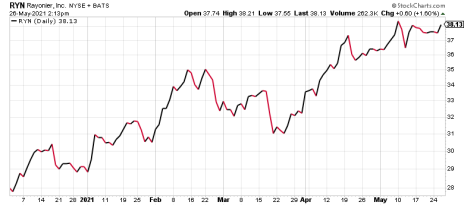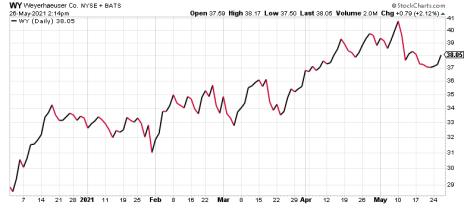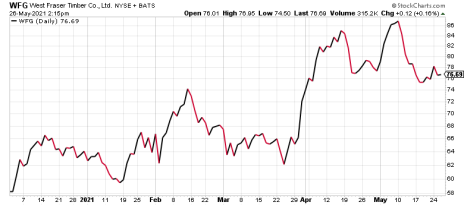Timber has been one of the most consistent investments over time, and a great hedge against inflation. According to value investor Jeremy Grantham, it’s risen 3% more than inflation for more than 90 years. With inflation concerns spiking, and a lumber shortage driving timberland prices up, that makes this a great time to invest in timber stocks.
Timberland (a.k.a. timber, lumber) has also beaten the stock market over the long run, and with less volatility. According to research produced by Boston-based GMO, where Grantham is co-founder and chief investment strategist, timber has risen steadily in price for 200 years and has returned an average of 6.5% a year during the last century. One reason for timber’s steady growth is that timber prices tend to follow population and economic growth. Emerging market nations such as China and South Korea are key drivers of growing demand for lumber products.
The returns on timber also hold up well in bad economies and bear markets. During the Great Depression, timber gained 233% while the price of stocks fell more than 70%.
[text_ad]
A unique characteristic of timberland compared to other agricultural commodities such as soybeans or wheat, is that it functions as both a factory and a warehouse. In other words, timber can be grown and then “stored on the stump.” This gives owners the flexibility of harvesting trees when timber prices are up, and delaying harvests when prices are down.
Here is another reason timber is a great shock absorber for your portfolio: It has a very low correlation with most asset classes, meaning it zigs when other asset classes zag. During one of the worst-ever bear markets in stocks from the late 1960s until about 1980, timber never had a losing year.
It is sometimes said that “trees don’t read the Wall Street Journal,” and so even in tough times, trees grow, compounding in size and value. This is why big institutional investors such as university endowments and pension funds make timber stock allocations in their giant portfolios.
Lastly, it is environmentally sustainable since we have certainly come a long way from the cut and burn practices used by the timber barons of the 19th century. Forestry, in America anyway, is now a sophisticated, sustainable and scientific business.
3 Timber Stocks to Buy Today
It’s no surprise then that as inflation fears have risen, so have timber stock prices.
The iShares Global Timber & Forestry ETF (WOOD), the leading exchange-traded fund that tracks the performance of timber stocks worldwide, is up 14.5% year to date, and a whopping 76% in the last year—both handily beating the S&P 500. And the best-performing timber stocks happen to be among WOOD’s top 10 holdings.
Those are…
Timber Stock #1: Rayonier (RYN)
WOOD’s second-largest holding, Rayonier is a mid-cap REIT based in Florida, but with assets in both the U.S. and New Zealand. Rayonier owns, leases or manages approximately 2.6 million acres of timberland located in America and 415,000 acres in New Zealand, in some of the most productive softwood timber growing regions in the world.
While Rayonier’s sales are expected to be flat this year, analysts expect the company to grow earnings per share by 60%. Meanwhile, the company rewards shareholders with a 2.9% dividend yield. RYN stock is up 29% year to date and 63% in the last year, though given the triple-digit valuation and the fact that shares are nearing 52-week highs, I’d start small and buy on pullbacks.
Timber Stock #2: Weyerhaeuser (WY)
Weyerhaeuser is kind of the large-cap version of Rayonier. It’s a REIT that owns 12.4 million acres of timberland in the U.S. and another 14 million in Canada. The company also manufactures its own wood products.
And while it’s a much larger company than Rayonier – it did $7.5 billion in sales in 2020, compared to just $860 million for Rayonier – it’s expected to grow much faster this year. Analysts expect Weyerhaeuser to grow sales by 34% this year and for EPS to more than double after a down 2020.
Given the cheap valuation (trading at just 11 times forward earnings estimates) and modest run-up so far this year (+13%), WY looks like the lowest-risk play on the timber boom right now.
Timber Stock #3: West Fraser Timber Company (WFG)
Now stepping outside U.S. borders – remember: trees grow everywhere! – West Fraser Timber is a mid-cap Canadian forestry company that produces lumber, plywood, pulp, newsprint, wood chips and other wood-related products from their headquarters in British Columbia. Perhaps more than any other company, West Fraser is expected to benefit from the ongoing lumber shortage that has timberland prices sky-high.
As a result, analyst expect the company’s top and bottom lines to more than double this year. And despite the stock being up 180% in the last year and 19% year to date, it’s trading at a dirt-cheap valuation of just three times forward earnings (and just five times trailing earnings).
WFG stock is currently trading near the low point of its two-month range of 75 to 86 and appears to be building a base. It looks extremely buyable right here.
Have you ever owned any timber plays? Do you own any stocks now that are inflation hedges? Tell us about both in the comments below.
[author_ad]




